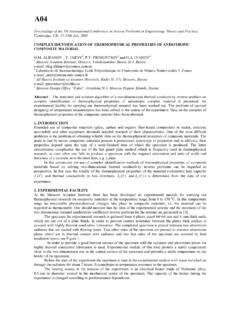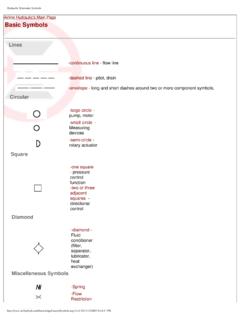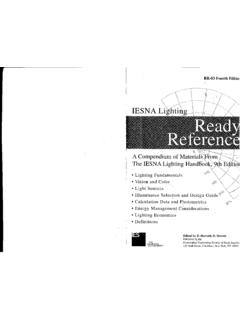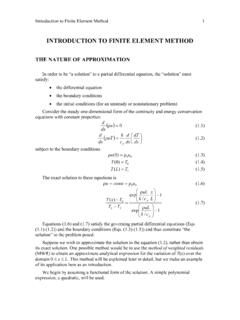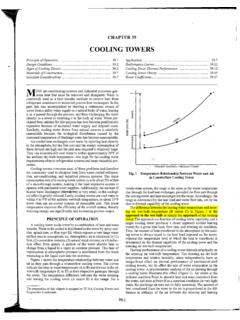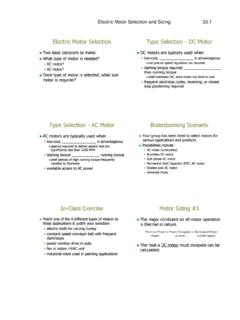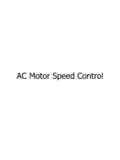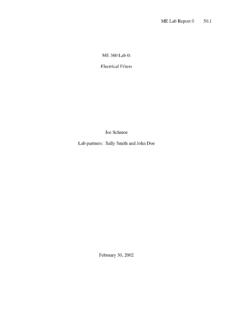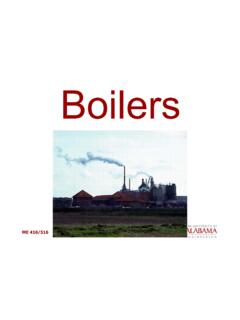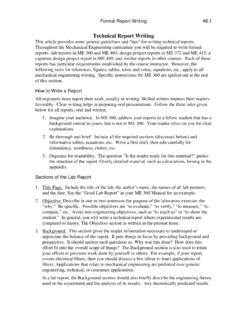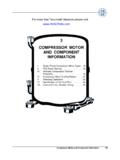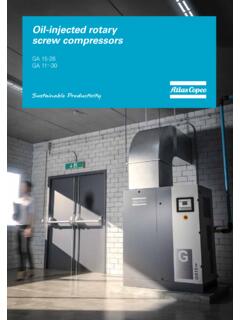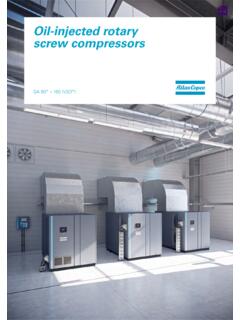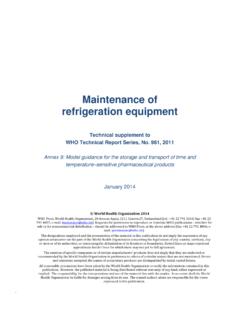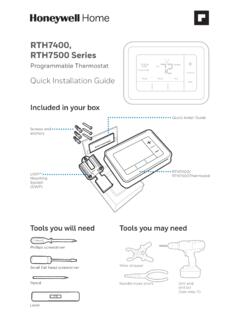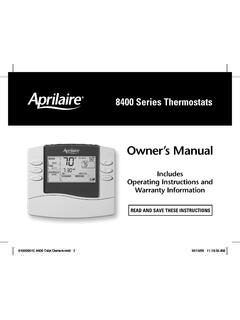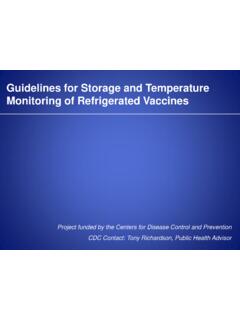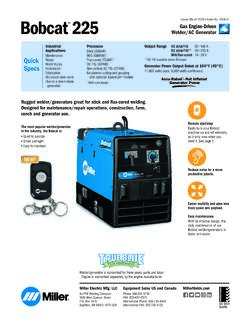Transcription of Energy Calculations of Large Buildings - University of Alabama
1 ME 416/516 Energy Calculationsof Large BuildingsME 416/516 Recall how we calculated For residential heat loss through envelope, used:q = A T/Rwhere R is the effective, overall R-value for the layers through which heat is transferred. For summer heat gain through envelope, used:q = A CLTD/Rwhere CLTD is the effective "cooling load temperature difference" that accounts for outside surface heating by the 416/516 Large Building Load For Large Buildings , conventional to use:q = U A T or q = U A CLTD U is the effective overall heat transfer coefficient. Comparing relations that use R to those that use U,U= 1 , overall heat transfer coefficient is simply the reciprocal of effective 416/516 Seasonal Performance Measures To simplify Energy Calculations , we use ratings that give an average efficiency over an entire heating or cooling season.
2 We ve seen: AFUE- Annual Fuel Utilization Efficiency for a fossil fuel fired furnace or water heater. HSPF- Heating Seasonal Performance Factor for an electric heat pump. SEER- Seasonal Energy Efficiency Ratio for electric cooling 416/516 What s Wrong with Seasonal Measures? The main problem with these ratings is that they do not account for equipment performance variations that occur hourly in response to changes in the weather. The design of HVAC systems for larger Buildings requires a more sophisticated Energy calculation procedure to account for variations in 416/516 The Bin Method The "bin method" refers to a procedure where monthly weather data is sorted into discrete groups (bins) of weather conditions.
3 Each bin contains the number of average hours of occurrence during a month or year of a particular range of weather condition. Example: The city of Tideville has the following dry bulb temperature bin data for the month of April:ME 416/516 Tdb Hours Range 82 2 80-84 77 14 75-79 72 38 70-74 67 89 65-69 62 115 60-64 57 128 55-59 52 106 50-54 47 88 45-49 42 75 40-44 37 43 35-39 32 18 30-34 27 4 25-29 ME 416/516 Bin Data The top row of the table indicates that April averages2 hours when Tdbis 80, 81, 82, 83 or 84 F, etc. The bin data are based on long-term weather measurements from National Weather Service. Similar bin tables are available for many weather stations for parameters including Twb, mean coincident Twbwith Tdb, wind speed, solar insolation, rainfall, etc.
4 , both monthly and annually. ASHRAE sells a CD-rom with much of the data, and NWS has a lot of data also (Web availability?)ME 416/516 Use of Bin Data Instead of using a single design condition for an entire year, an engineer can calculate loads for each bin condition, multiply the bin load by the hours of occurrence for that bin, then sum the load for each bin to get the total :Find the April heating load for a building in Tideville that is kept at Ti= 68 F and has an overall value of UA = 112,000 Btu/hr- F, where q = U A 416/516 Tdb Hours T ( F)q MBtuh Q MMBtu82 2 ----- ----- ----- 77 14 ----- ----- ----- 72 38 ----- ----- ----- 67 89 ----- ----- ----- 62 115 6 672 57 128 11 1232 52 106 16 1792 47 88 21 2352 42 75 26 2912 37 43 31 3472 32 18 36 4032 27 4 41 4592 Qtotal = 1091 ME 416/516 Bin Method Energy Calculations The previous example illustrates advantages of load calculation by the bin method.
5 Although the example given showed a directly linear relationship between T and q, there are cooling or heating loads that vary nonlinearly. Using the bin method results in a more accurate calculation of the total load, Q. When the weather varies hour-by-hour, the demand put on the heating and cooling equipment varies, plus equipment performance varies at different weather 416/516 Bin Method Accounts for Weather Effects Better The accuracy of calculating the equipment Energy use is improved by using the bin method even more than was the load calculation. For equipment that operates on the refrigeration cycle, such as air conditioners and heat pumps, performance and capacity depend strongly on the weather, for several 416/5161stWeather Effect on Equipment PerformanceThe maximum possible efficiency of refrigeration cycle drops as T increases.
6 For example, the theoretical COP of a heat pump (heating) is:COPC arnot= TH/(TH-TC) Here TH= Tiand TC= Tod. For Ti= 67 F, the max. theoretical COP is about 26 for Tod= 47 F but only about for Tod= 17 F, a drop of 75%. Actual COP's are much lower COPC arnot. Standard , for example, requires small heat pumps to have COP > 3 at 47 F and COP > 2 at 17 416/5162ndWeather Effect: A/C Capacity Drops at HighTod A/C and heat pump capacity drops as T rises. In order to reject heat to hot outside air, an A/C, , must have a condenser refrigerant temperature significantly higher than Tod. As Todrises, the compressor outlet pressure rises to reject heat. There is a limit to how much pressure increase can be achieved by motor, so as outdoor temperature gets higher, the T between refrigerant and air gets smaller.
7 Heat rejection, which is proportional to this T, drops, thereby reducing A/C 416/5163rdWeather Effect: HP Capacity Drops at LowTod Same capacity loss occurs for a heat pump (heating) as Toddrops, but the situation is worse. A heat pump also loses capacity in cold weather because it has to go into defrost mode, where it actually runs in reverse, blowing warm air out through the outdoor unit to melt ice that has frozen on the coils during the normal mode of 416/5164thWeather Effect: Capacity is Exceeded in Extreme Weather A final effect of weather conditions is that as T increases, the heating or cooling load rises proportionally, and at some point the machine capacity is exceeded. For A/C, the building gets warmer.
8 For heat pump, auxiliary "strip" resistance heat is activated, working at COP = 1. If the system is sized adequately, the thermal capacity of the system will allow the building to flywheel through normal extreme weather without getting excessively hot or 416/516 Part-Load Performance A heating or cooling system ( Large or small) operates at only a fraction of its capacity most of the time, at the part-load condition. The part-load efficiency is less than full-load because of transient losses, the need to reheat or recool ductwork when the system comes back on, operation of pumps and fans at full speed when not needed, throttling losses, etc. The system efficiency is deratedto account for reduced part-load 416/516 Part-Load Derating Efficiency, , COP, is derated at part load as:COPpart= COPfull* CCAF whereCCAF = [1 - *( 1 - PLF)]and the part-load factor PLF is the fraction of full load at which the system is operating:PLF = Load/Capacity For periods where load exceeds capacity, the system operates at full capacity, PLF = 1, and CCAF = 416/516 Bin MethodExample A building in Tideville has a heat pump that operates with the temperature dependent capacity and COP shown in the following table.
9 The COP at part load operation is calculated as When the cooling load exceeds the heat pump capacity, auxiliary strip heat kicks in to make up the difference. The strip heat has COP =1. Find the demand in kW for the system and the monthly Energy use in 416/516 Tdb Hours q MBtuhCap PLF COP ratedCOP part 82 2 ----- 77 14 ----- 72 38 ----- 67 89 ----- 62 115 672 3506 57 128 1232 3300 52 106 1792 3094 47 88 2352 2901 42 75 2912 2695 37 43 3472 2500 32 18 4032 2294 27 4 4592 2098 ME 416/516 Tdb F Hours q MBtuhCap MBtuhCOP part kW kWh 82 2 ----- 77 14 ----- 72 38 ----- 67 89 ----- 62 115 672 3506 9721 57 128 1232 3300 106 1792 3094 88 2352 2901 75 2912 2695 43 3472 2500 18 4032 2294 27 4 4592 2098 Total111124 ME 416/516 Notes on Bin Method Example No heating is done when temperature is above 65 F
10 (depending on internal heat sources, etc., no heating may be necessary until Todis considerably lower). "Cap." is the capacity (total heat input rate that can be provided) of the heat pump that is heating the building. Note that capacity drops as Todgets 416/516 More Notes on Bin Method Example The "kW" column is the electric power demand of the heat pump at a given condition, obtained from:kW = q (Btu/hr)/(COP * 3412 Btu/kWh)where q is the building load for conditions where PLF < 1 and q is the heat pump capacity for conditions where the heat pump is operating continuously. The kWh column is the product of kW and the number of hours in a particular 416/516 Tdb F Hours q MBtuhCap. MBtuhCOP part Aux kW Aux KWh82 2 ----- 77 14 ----- 72 38 ----- 67 89 ----- 62 115 672 3506 0 57 128 1232 3300 0 52 106 1792 3094 0 47 88 2352 2901 0 42 75 2912 2695 4770 37 43 3472 2500 18 4032 2294 27 4 4592 2098 Total29112 ME 416/516 More Notes on Bin Method Example The "Aux.
